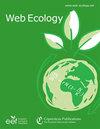Components of standard metabolic rate variability in three species of gammarids
IF 2.4
3区 环境科学与生态学
Q2 ECOLOGY
引用次数: 10
Abstract
Abstract. Standard metabolic rate is a major functional trait with large inter-individual variability in many groups of aquatic species. Here we present results of an experimental study to address variation in standard metabolic rates, over different scales of organisation and environments, within a specific group of aquatic macro-invertebrates (i.e. gammarid amphipods) that represent the primary consumers in detritus food webs. The study was carried out using flow-through microrespirometric techniques on male specimens of three gammarid species from freshwater, transitional water and marine ecosystems. We examined individual metabolic rate variations at three scales: (1) at the individual level, during an 8 h period of daylight; (2) at the within-population level, along body-size and body-condition gradients; (3) at the interspecific level, across species occurring in the field in the three different categories of aquatic ecosystems, from freshwater to marine. We show that standard metabolic rates vary significantly at all three scales examined, with the highest variation observed at the within-population level. Variation in individual standard metabolic rates during the daylight hours was generally low (coefficient of variation, CV<10 %) and unrelated to time. The average within-population CV ranged between 30.0 % and 35.0 %, with body size representing a significant source of overall inter-individual variation in the three species and individual body condition exerting only a marginal influence. In all species, the allometric equations were not as steep as would be expected from the 3∕4 power law, with significant variation in mass-specific metabolic rates among populations. The population from the transitional water ecosystem had the highest mass-specific metabolic rates and the lowest within-population variation. In the gammarid species studied here, body-size-independent variations in standard individual metabolic rates were higher than those explained by allometric body size scaling, and the costs of adaptation to short-term periodic variations in water salinity in the studied ecosystems also seemed to represent a major source of variation.三种伽玛鱼的标准代谢率变异性组成
摘要标准代谢率是许多水生物种群体中个体间差异较大的主要功能性状。在这里,我们提出了一项实验研究的结果,以解决在不同规模的组织和环境中,在一组特定的水生大型无脊椎动物(即- marid片脚类动物)中标准代谢率的变化,这些动物代表了碎屑食物网的主要消费者。该研究采用了流式微呼吸测量技术,对来自淡水、过渡水和海洋生态系统的三种伽玛体雄性标本进行了研究。我们在三个尺度上检查了个体代谢率的变化:(1)在个体水平上,在8小时的日光期间;(2)在种群内水平上,沿体型和身体状况梯度;(3)在种间水平上,在从淡水到海洋的三种不同类型的水生生态系统中发生的跨物种。我们表明,标准代谢率在所有三个尺度上都有显著变化,在种群内水平上观察到的变化最大。白天个体标准代谢率的变化通常较低(变异系数,CV< 10%),且与时间无关。种群内的平均变异系数在30.0%到35.0%之间,体型是三个物种整体个体间变异的重要来源,个体的身体状况只产生很小的影响。在所有物种中,异速生长方程并不像从3 / 4幂律中所期望的那样陡峭,种群之间的质量特定代谢率存在显著差异。过渡水生态系统种群的质量比代谢率最高,种群内变异最小。在这里所研究的伽玛种群中,个体代谢率的独立于体型的变化高于异速体大小比例所解释的变化,并且在所研究的生态系统中,适应水盐度的短期周期性变化的成本似乎也代表了变化的主要来源。
本文章由计算机程序翻译,如有差异,请以英文原文为准。
求助全文
约1分钟内获得全文
求助全文
来源期刊

Web Ecology
Agricultural and Biological Sciences-Ecology, Evolution, Behavior and Systematics
CiteScore
4.60
自引率
0.00%
发文量
6
审稿时长
17 weeks
期刊介绍:
Web Ecology (WE) is an open-access journal issued by the European Ecological Federation (EEF) representing the ecological societies within Europe and associated members. Its special value is to serve as a publication forum for national ecological societies that do not maintain their own society journal. Web Ecology publishes papers from all fields of ecology without any geographic restriction. It is a forum to communicate results of experimental, theoretical, and descriptive studies of general interest to an international audience. Original contributions, short communications, and reviews on ecological research on all kinds of organisms and ecosystems are welcome as well as papers that express emerging ideas and concepts with a sound scientific background.
 求助内容:
求助内容: 应助结果提醒方式:
应助结果提醒方式:


